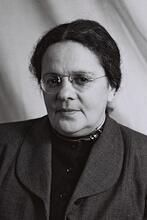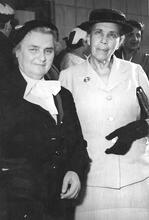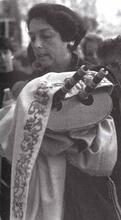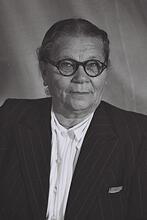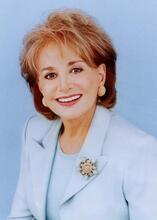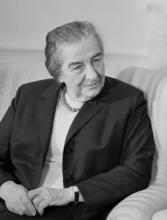Golda Meir
During the 1970s, Golda Meir (1898 – 1978) was voted the Most Admired Woman in America at the same time as she was American feminism's poster girl, the face above the caption "But Can She Type?" In reality, however, she never used her position to advance the cause of women's rights and equality in Israeli society.
Institution: U.S. Library of Congress.
Golda Meir served as Israel’s first female Prime Minister through the turbulent period of the Yom Kippur War. Meir’s passion for Labor Zionism drove her to make Aliyah and join a kibbutz in 1921. She became secretary of Histradut’s Mo’etzet ha-Po’alot, the Women Workers Council, and later head of Histradut’s political department. In 1949, she was elected to the Knesset and became Minister of Labor before becoming Foreign Minister in 1956 and Prime Minister in 1969. While Israel was able to regain the offensive after the Yom Kippur War, the massive casualties of the war were seen as Meir’s failure, and she resigned from office in 1974. However, over time her accomplishments as a stateswoman have been recognized again.
Background
In the pantheon of illustrious national leaders there exists an even more elite subgroup, female heads of state, among whom stands one Jewish woman: Golda Meir, the Prime Minister of Israel from 1969 to 1974. Pioneer, visionary, risk-taker, indefatigable fund-raiser, eloquent advocate, she was an activist of the first order, one of the founders of the Jewish state, a woman whose life story is as central to the mythos of modern Zionism as that of Theodor Herzl, Chaim Weizmann, and David Ben-Gurion. Presidents and kings found her willfulness charming, while her grandmotherly appearance and plain-spoken personal style endeared her to ordinary people around the world. In her time, Golda was as admired as Queen Elizabeth and as well known by her first name as Madonna is today. Yet, for all her accomplishments and fame, Golda Meir—like Indira Gandhi of India and Margaret Thatcher of Great Britain—was no particular friend of women. She was, in current parlance, a “queen bee,” a woman who climbs to the top, then pulls the ladder up behind her. She did not wield the prerogatives of power to address women’s special needs, to promote other women, or to advance women’s status in the public sphere. The fact is that at the end of her tenure her Israeli sisters were no better off than they had been before she took office. That a notable female can be simultaneously an inspiration and a disappointment, a source of great pride and of deep frustration, is the unique contribution of the queen bee to women’s history in general, and of Golda Meir to Jewish women’s history in particular.
Family and Early Life
Meir was born on May 3, 1898, in Kiev, Ukraine. Her father, Moshe Mabovitch, a skilled carpenter, and her mother, Blume Naidtich, named her for her maternal great-grandmother, a domineering matriarch who lived to be ninety-four and who always took salt instead of sugar in her tea to remember the bitterness of the Jewish Lit. (Greek) "dispersion." The Jewish community, and its areas of residence, outside Erez Israel.Diaspora. Golda Meir was pleased with this legacy. She identified most, she said, with her “tenacious,” “intransigent” relatives, especially her paternal grandfather, who was kidnapped at age thirteen into the Czar’s army but resisted conversion to Christianity and refused to eat traif (nonkosher food). The Mabovitches kept Term used for ritually untainted food according to the laws of Kashrut (Jewish dietary laws).kosher (kasher), observed Jewish holidays, and shared traditional Sabbath meals with their extended family—all later lost in the Holocaust. Meir remembered everyone sitting around the table singing Hebrew songs, yet she described growing up in “a not particularly religious household.” She vividly recalled her early childhood as a time of abject poverty and terrifying pogroms, and she attributed her lifelong commitment to Jewish security to her memories of antisemitic violence and the experience of hiding from the Cossacks. She also remembered her sister Sheyna, nine years her senior, risking her life to attend Labor Zionist meetings, and her sister Zipke, the baby, getting the lion’s share of their meager gruel. In 1903, Moshe left for America; three years later, he sent for his family and settled them in a two-room flat in the poor Jewish section of Milwaukee. Golda was eight years old.
On the surface, her life story seems to follow the classic immigrant trajectory toward her rendezvous with destiny. But behind the facts lie years of searing family tensions, conflicts between her goals and others’ expectations of her, and painful inner struggles that might have fueled a feminist consciousness had she not interpreted them as problems unique to her.
At fourteen, Meir graduated from the Fourth Street Elementary School as class valedictorian but had to fight her parents for the right to go to high school. She wanted to be a teacher; they wanted her to find a husband. “It doesn’t pay to be too clever,” warned her father. “Men don’t like smart girls.” Defying him, she enrolled in Milwaukee’s North Division High School and took after-school jobs to pay her expenses. Still, the arguments raged.
Fed up, Meir ran away to live with her sister and brother-in-law in Denver, where she attended school and spent her evenings listening to Shayna’s radical friends—anarchists, Socialist Zionists, and Labor Zionists whose debates helped refine Golda’s political philosophy. She also fell in love with Morris Myerson, a quiet, bespectacled sign-painter who loved poetry and music and exposed her to lectures on literature and history but who never fully shared her Zionist passion. A letter of apology from her parents allowed her to return home after a year, and in 1916 she graduated from high school and registered for a three-year program at the Milwaukee Normal School, a teachers’ training college. Three times a week, she taught children reading, writing, and history at a folkshule, a Yiddish school at the Jewish Center of Milwaukee, but her real teaching took place on street corners—much to her father’s distress—where she lectured on Labor Zionism.
Immigration to Palestine
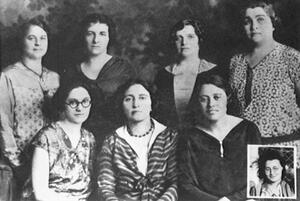
The Women's Organization for the Pioneer Women of Palestine was officially founded in 1925. (It changed its name to Pioneer Women in 1939 and is today called Na'amat.) This early photograph of its leaders includes (L to R, standing): Leah Brown, Goldie Meyerson (Golda Meir), Miriam Meltzer and Nina Zuckerman; (seated): Leah Biskin, Rahel Siegel, Fiegel Berkinblitt. Insert: Chaya Ehrenreich.
Institution: Private collection
In November 1917, Britain issued the Balfour Declaration supporting “the establishment in Palestine of a National Home for the Jewish people.” A month later, on Christmas Eve, Golda Mabovitch married Morris Myerson on the condition that they would immigrate to Palestine and live on a A voluntary collective community, mainly agricultural, in which there is no private wealth and which is responsible for all the needs of its members and their families.kibbutz. (A decade before her, the first kibbutz was created by a woman, Mania Shochat.) They chose Merhavyah in the Emek, an area of festering malarial swamps, with, as she put it, “no orchards, no meadows, no flowers, nothing.” But when they arrived in 1921, the admission committee rejected them, saying the kibbutz was not ready for married couples. Stunned, they applied again and were granted a probationary residency during which Golda picked almonds and planted saplings, Morris worked the fields, and the kibbutz members became enamored of Morris’s phonograph and classical records. This time, they were accepted.
Before long, Meir became a model kibbutznik and such an expert on breeding and feeding chickens that the kibbutz sent her to Haifa for a management course and later chose her as its representative to the Histadrut [General Federation of Labor].
While Golda was flourishing, Morris, who had contracted malaria, felt useless and disconsolate. He flatly refused to have children unless she agreed to rear them in a conventional family setting. After two and a half years (“the happiest of my life”), they left Merhavyah for Jerusalem, where Golda—giving birth to a son, Menachem, in 1924, and a daughter, Sarah, in 1926—valiantly tried to be a traditional wife and mother amid a life of grinding poverty. Morris worked as a bookkeeper for the Histadrut Building Office, which didn’t always pay its salaries, and Golda scrimped and bartered to make ends meet. In exchange for Menachem’s nursery school fees, she did the school’s laundry by hand, not minding the work but longing for labor with a Zionist purpose and desperate for meaningful community. Now it was her turn to feel useless and disconsolate.
One day in 1928, she ran into an old friend, David Remez, who offered her the job of secretary of Histadrut ’s Mo’ezet ha-Po’alot, Women Workers Council. Knowing Morris would never approve, she nonetheless took the job and moved to Tel Aviv with her children and her sister. Morris visited on weekends but, in essence, their marriage was over. The separation became final ten years later—though they were never legally divorced—yet until Morris’s death in 1951, Golda would continue to feel guilty “because I couldn’t be the wife he wanted and should have had.” She would also worry that she had not done enough for her children. “I was always rushing from one place to another—to work, home, to a meeting, to take Menachem to a music lesson, to keep a doctor’s appointment with Sarah, to shop, to cook, to work and back home again. And still to this day,” she wrote at age seventy-seven, “I am not sure that I didn’t harm the children or neglect them.” At the same time, she acknowledged, “There is a type of woman who cannot let her husband and children narrow her horizons.”
Establishment of Israel
Moving quickly up the ranks, Meir became a member of the Executive Committee of the Histadrut in 1934 and head of its political department two years later. During World War II, she held several key posts in the World Zionist Organization and in the Jewish Agency, the highest Jewish authority in British-administered Palestine, which functioned as the government of the Jewish community in Palestine prior to the establishment of the State of Israel. "Old Yishuv" refers to the Jewish community prior to 1882; "New Yishuv" to that following 1882.Yishuv (Jewish settlement). When the male leadership was arrested for smuggling in refugees, she served as acting head of the agency, and until the end of the mandate she was its spokesperson in dealings with the British.
With the establishment of the State of Israel in 1948, it became clear that armed confrontation with the Arabs was inevitable. A vast amount of money was needed to equip the armed forces. Because she spoke perfect English, Meir volunteered to go to the United States to solicit twenty-five million dollars from the American Jewish community. Where others had tried and failed, she succeeded in communicating both a compelling urgency and a sense of shared mission. She raised not twenty-five but fifty million dollars.
Her courage took many forms. In May 1948, with five Arab armies massed on Israel’s borders, Meir disguised herself as a Muslim woman and crossed into Trans-Jordan for a secret meeting with King Abdullah, to try to persuade him to stay out of the war. Abdullah, King Hussein’s congenial grandfather, with whom she had already had two clandestine encounters, received her with respect but remained unresponsive to her pleas.
When Israel was just four days old and in the thick of battle, Meir returned to the United States to do more fundraising for the war effort. A month later, Foreign Minister Moshe Sharett appointed her ambassador to the USSR—sweet revenge for the little girl once menaced by the Cossacks and a profound thrill for Soviet Jews who, at great peril to themselves, thronged the Moscow synagogue on Rosh Hashanah to greet her. In 1949, she was elected to the Lit. "assembly." The 120-member parliament of the State of Israel.Knesset (Israeli parliament) and appointed by Prime Minister David Ben-Gurion to be the Minister of Labor, in charge of finding jobs and housing for the nearly seven hundred thousand immigrants who streamed into the country between May 1948 and the end of 1951.
Foreign Minister
Meir held the Labor portfolio for seven years. She said she would have liked to keep it forever, but in 1956, Ben-Gurion made her Foreign Minister, the second-highest position in the government. He also insisted she adopt a Hebrew-sounding surname to better represent her Hebrew-speaking nation; thus did Myerson became Meir.
The only female foreign minister in the world, Golda Meir was also the only foreign minister who had no use for formalities, who flew tourist class, who shocked hotel staffs by handwashing her own underwear and shining her own shoes, and who entertained foreign dignitaries in her kitchen, in an apron, serving them her homemade pastry along with a stern lecture on Israel’s security. She also was a foreign minister who refused to obey the color line in Rhodesia, inspiring a full complement of dignitaries to follow suit, and whose proudest accomplishment was the export of Israeli technical and agricultural expertise to the African nations.
In 1966, she decided to retire from government; Abba Eban would take over her post. She was sixty-eight years old, ready to become a full-time grandmother, eager to do more reading, listen to music, bake, visit friends, slow down. A year earlier, she had been diagnosed with lymphoma, a condition she insisted upon keeping secret and for which she was treated at Hadassah Hospital in the dead of night.
Prime Minister
Although Meir considered her public career at an end, she was persuaded to become secretary general of Mapai, her political party, and, in 1967, secretary of the unified Labor Party. Then suddenly, in February 1969, Prime Minister Levi Eshkol died of a heart attack and, to avoid a power struggle between Moshe Dayan and Yigal Allon, the party prevailed upon her to become Israel’s leader. Retirement would have to wait.
Meir might have enjoyed more than four years in power had not Egypt and Syria launched a surprise attack on October 6, 1973, to start the The Day of Atonement, which falls on the 10th day of the Hebrew month of Tishrei and is devoted to prayer and fasting.Yom Kippur War. Though Israeli forces were able to regain the offensive, they suffered more than twenty-seven hundred casualties, a profound blow to a small country, and especially to Jews, who measure their collective survival one life at a time. Until the day she died, Meir regretted that she had not followed her instincts to call up the reserves days earlier rather than heeding the advice of military intelligence experts who saw no reason to mobilize. Gripped by a kind of national trauma, the public turned against her; parents of the dead shouted at her in the streets and blamed her and Defense Minister Dayan for the devastating losses. Although the Labor Party won the election of December 1973, Golda Meir was unable to form a government. She resigned on April 10, 1974, and on June 3, officially turned over the premiership to Yitzhak Rabin.
Impact
For all her grief and remorse over the Yom Kippur War, for all the humiliation and pain of her people’s rejection of her, she was nonetheless able in her final years to evolve into an elder statesman and beloved public citizen, a woman whom bus drivers insisted on taking to her front door and whom organizations clamored to honor. In time, her image regained its luster, and her reputation as a philosopher-comedian entered the realm of legend.
As a politician and Jewish nationalist, Meir was consistent, strong in her resolve, and undisturbed by nuance or self-doubts. The Zionist cause to her was a moral, historical, and political imperative. Though she was eager to make peace with “the Arabs,” and often begged for Arab recognition and Arab partners, her refusal to acknowledge the existence of “Palestinians” or, consequently, Palestinian suffering, was for many years a stumbling block to progress.
As a woman, on the other hand, Meir was a study in contradictions. Though her public persona was almost neuter, she was reputed to have had many lovers for many years. Foremost among them were David Remez, Israel’s Minister of Transport and then of Education, and by some accounts the true passion of her life; and Zalman Shazar, one of the preeminent architects of the Jewish state and eventually its president. Though she exhibited stereotypically feminine attributes—the cooking, the warmth and emotionality, the matronly appearance—those who knew her never fail to mention her toughness.
“To survive Israeli politics she had to become tough, she had no choice; she must have gone through hell to get where she did,” says M.K. Colette Avital, who began her career in Israel’s foreign ministry under Meir’s tenure and became one of her nation’s top-ranking foreign service officers. Avital remembers her old boss as someone who could be rigid and hot-tempered, someone who “disliked women, never really helped women.”
Jew, Zionist, Israeli—these were the identities that defined Golda Meir’s life and galvanized her loyalties while the female aspect of her being remained devoid of consciousness or commitment. (“Whether women are better than men I cannot say,” she once wrote, “but I can say they are certainly no worse.”) While she was voted the Most Admired Woman in America during the 1970s, simultaneously serving as feminism’s poster girl—the face above the caption “But Can She Type?”—the reality was far more complex. She acknowledged the important role women played in the founding of the State of Israel but was unwilling to bond in solidarity with her sex. Rather than recognize in her life experience the untenable pressures that plague virtually all achieving women, she attributed her strains and sacrifices to her private feminine or maternal failures, faulting her own aspirations, her love of political work, and her burning ambitions for the Jewish state. As Prime Minister, she did not focus on child care policy or concern herself with the problems of working women or use her influence to argue for equal gender arrangements in the home or encourage more women to run for public office. The conflicts that tore her apart helped her to sympathize passively with the “heavy double burden” of working mothers but did not inspire her to politicize that sympathy and identify with feminist goals. In fact, she seemed to go out of her way to criticize feminism and distort the tenets of the women’s movement. She did, however, have her epiphanic moments. When Israel was experiencing an epidemic of violent rapes and someone at a cabinet meeting suggested women be put under curfew until the rapists were caught, Meir shot back, “Men are committing the rapes. Let them be put under curfew.”
When Ben-Gurion first made her a minister in his cabinet, the religious bloc objected to the idea of a woman ruling over men, though they finally acquiesced on the grounds that Deborah, the biblical judge, had been acceptable to God. However, when Meir was a candidate for mayor of Tel Aviv, the religious objections defeated her, to her everlasting fury. When Ben-Gurion described her as “the only man” in his cabinet, Golda was amused that he thought “this was the greatest possible compliment that could be paid to a woman. I very much doubt that any man would have been flattered if I had said about him that he was the only woman in the government!” She noticed the disparity but seemed to miss the larger point. She once said in a speech to the UN that the world might be better off if political leaders allowed themselves to “feel more and think less.” Yet she did not deduce that having more women in power might add the missing component to public life.
Just as some Jews choose not to be Jewish-identified because they think they have the option to behave as if peoplehood doesn’t matter, Golda Meir chose not to be woman-identified and behaved as if gender doesn’t matter. But, of course, when one is Jewish and female, both facts matter.
She died on December 8, 1978, at age eighty, a titan of modern Zionism, a history-making national leader, one of the most accomplished women of the twentieth century—still feeling guilty about falling short as a wife and mother.
Selected Works by Golda Meir
A Land of Our Own: An Oral Autobiography, edited by Marie Syrkin (1973); My Life (1975).
This Is Our Strength, edited by Henry M. Christman (1962).
Agress, Eliyahu. Golda Meir: Portrait of a Prime Minister (1969).
Ander, Richard. Golda Meir: A Leader in Peace and War (1990); Ben-Gurion, David. Memoirs (1970).
Davidson, Margaret. The Golda Meir Story (1981).
Klagsbrun, Francine. Lioness: Golda Meir and the Nation of Israel (2017).
Mann, Peggy. Golda: The Life of Israel’s Prime Minister (1972).
Martin, Ralph G. Golda: Golda Meir—The Romantic Years (1988).
A Woman Called Golda. Feature film. Paramount Pictures (1982).

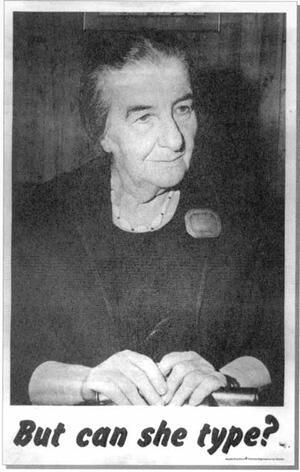
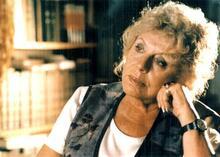
![Hauser, Rita - still image [media] Hauser, Rita - still image [media]](/sites/default/files/styles/medium/public/mediaobjects/Hauser-Rita.jpg?itok=tQjSWodv)
